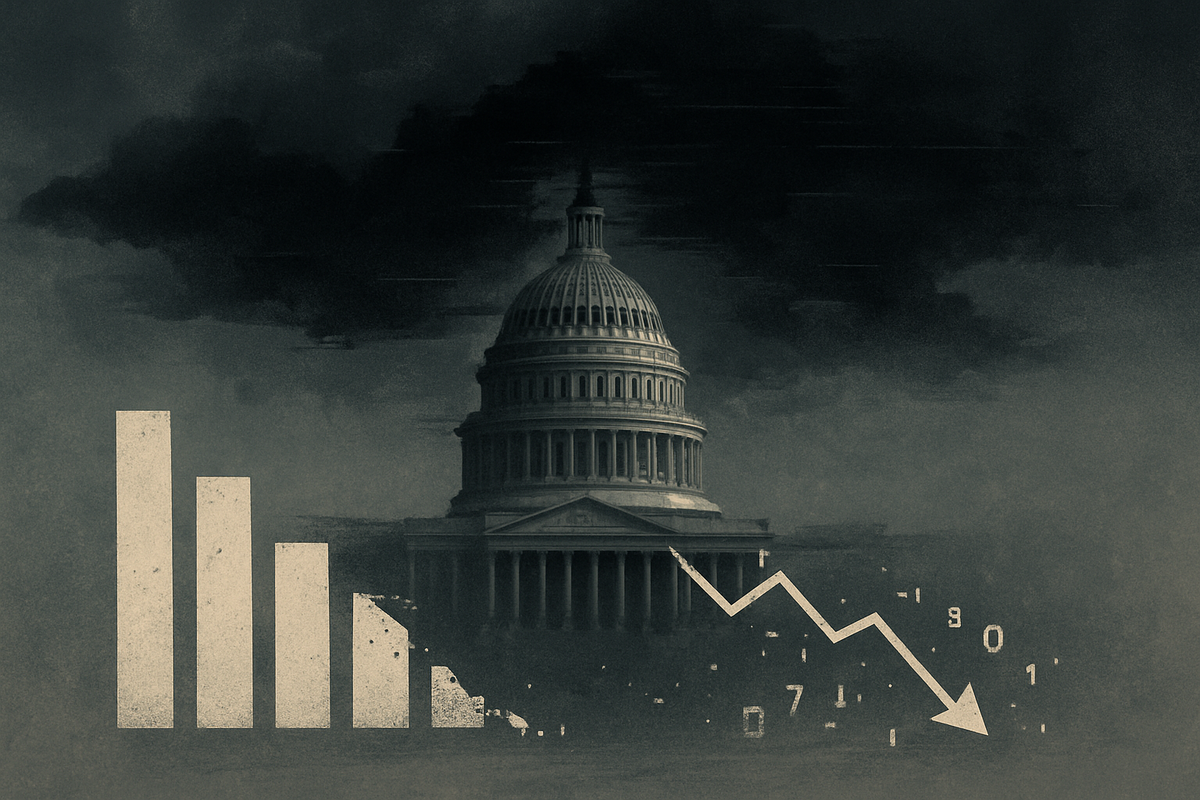
The United States finds itself in an unprecedented economic fog as a prolonged government shutdown, now stretching well into its second month, has brought the flow of critical official data to a grinding halt. With federal agencies responsible for collecting and disseminating vital economic indicators largely shuttered, policymakers, businesses, and investors are left navigating a landscape devoid of crucial information, fueling uncertainty and sparking jitters across the stock market. The current shutdown, which commenced on October 1, 2025, has already surpassed historical precedents in length, raising concerns about its cumulative impact on the nation's economic health and market confidence.
This extended period of governmental inactivity is not merely a political stalemate; it translates directly into a "data blackout" that obscures the true state of the U.S. economy. Key reports on employment, inflation, consumer spending, and GDP, which serve as the bedrock for informed financial decisions, are either delayed indefinitely or not being compiled at all. This information vacuum creates a challenging environment for the Federal Reserve, which relies on timely and accurate data to formulate monetary policy, and for investors attempting to assess market valuations and future growth prospects. While historical data suggests that markets often prove resilient to brief shutdowns, the sheer duration of the current impasse threatens to erode this resilience, potentially leading to more significant and lasting economic repercussions.
Unprecedented Delays and Market Volatility Mark a Historic Shutdown
The current US government shutdown, initiated on October 1, 2025, has rapidly evolved into a historic event, eclipsing previous records for duration. As of early November 2025, this prolonged impasse has resulted in the suspension of operations for numerous federal agencies, including critical data-gathering bodies such as the Bureau of Labor Statistics (BLS), the Bureau of Economic Analysis (BEA), and the Census Bureau. This has led to an unprecedented halt in the release of essential economic indicators, including the eagerly anticipated monthly jobs report, Consumer Price Index (CPI), retail sales figures, and housing market data. The absence of these reports leaves a gaping hole in the economic narrative, making it extraordinarily difficult to ascertain the true health and direction of the US economy.
The timeline of events leading to this moment has been characterized by deep political divisions over budgetary appropriations, with key players in Congress and the White House failing to reach a consensus on spending bills. This political deadlock ultimately triggered the automatic shutdown of non-essential government services. Initial market reactions to the shutdown were characterized by heightened volatility and a cautious retreat. Futures on major indices like the Nasdaq 100 and S&P 500 (SPX) experienced declines in early trading following the onset of the shutdown, reflecting investor anxiety over the immediate political instability and the looming data vacuum.
Historically, the stock market's reaction to government shutdowns has been mixed, often demonstrating a degree of resilience, especially during shorter impasses. For instance, the S&P 500 (SPX) managed to advance by 3.1% during the 16-day shutdown in 2013, and even during the 35-day shutdown from December 2018 to January 2019, the S&P 500 (SPX) saw a spike of 9.3%. However, these historical precedents involved shorter durations or different economic backdrops. The current, exceptionally long shutdown introduces a new level of uncertainty, as the cumulative effect of delayed data and prolonged federal worker furloughs could have a more pronounced impact on GDP growth and consumer confidence, potentially challenging the market's historical resilience.
The key stakeholders involved include various government departments, federal employees, government contractors, and, by extension, the entire American populace and global financial markets. Furloughed federal workers face missed paychecks, impacting their spending power and local economies, while businesses reliant on government permits, inspections, or contracts face significant operational disruptions. This widespread impact contributes to the overall downturn in sentiment, as the economic ripple effects begin to spread beyond just the immediate government sector.
Companies Facing Headwinds and Tailwinds Amidst the Shutdown
The protracted US government shutdown creates a bifurcated landscape for public companies, with some sectors and individual firms facing significant headwinds while others might experience limited impact or even unexpected tailwinds. Companies heavily reliant on government contracts, particularly in defense, technology, and services, are among the most vulnerable. Firms like Lockheed Martin (NYSE: LMT), Boeing (NYSE: BA), and Raytheon Technologies (NYSE: RTX) could see delays in contract approvals, payment processing, and new project initiations. While many large defense contractors have diverse portfolios that can buffer some impact, a prolonged shutdown can still lead to a slowdown in cash flow and project timelines, potentially affecting quarterly earnings. Similarly, IT service providers to federal agencies, such as Booz Allen Hamilton (NYSE: BAH) or CACI International (NYSE: CACI), face direct operational disruptions as their government clients are furloughed.
Beyond direct government contractors, industries that rely on federal permits, inspections, or regulatory approvals are also significantly impacted. The pharmaceutical sector, for instance, could experience delays in drug approvals from the Food and Drug Administration (FDA), affecting companies like Pfizer (NYSE: PFE) or Johnson & Johnson (NYSE: JNJ) and their ability to bring new products to market. Energy companies requiring permits from the Department of Interior or Environmental Protection Agency (EPA) for drilling or infrastructure projects might see their operations stalled. Small businesses, particularly those seeking Small Business Administration (SBA) loans or other federal assistance, are especially vulnerable, as the processing of these applications comes to a standstill, potentially impacting their ability to operate or expand.
On the flip side, some companies or sectors might be less affected or even see indirect benefits. Large, diversified companies with minimal exposure to federal contracts or regulatory processes might weather the storm better. Consumer staples companies like Procter & Gamble (NYSE: PG) or Walmart (NYSE: WMT), while not immune to a general economic slowdown, are less directly impacted by the mechanics of a government shutdown. Furthermore, sectors that thrive on market volatility or provide essential services that are not government-dependent could see relative stability. Companies providing private economic data or analytics might even see increased demand as investors seek alternative sources of information to fill the void left by official government statistics. However, the overarching climate of uncertainty and potential for broader economic contraction generally creates a challenging environment for most businesses, making true "winners" scarce in a prolonged shutdown scenario.
Broader Significance: Eroding Confidence and Challenging Economic Models
The ongoing US government shutdown extends its influence far beyond immediate market fluctuations and corporate balance sheets; it represents a significant challenge to broader industry trends, regulatory stability, and the fundamental confidence in governmental functionality. In an increasingly data-driven global economy, the prolonged "data blackout" is particularly problematic. Financial institutions, multinational corporations, and international trade partners rely on the consistent flow of US economic indicators to inform their strategic planning, investment decisions, and risk assessments. The absence of this data not only creates uncertainty but can also lead to mispricings in various markets, as participants are forced to operate with incomplete or outdated information. This event underscores the critical role of government statistical agencies in maintaining market transparency and efficiency, highlighting a vulnerability that was perhaps underestimated in an era of abundant information.
The ripple effects of this shutdown are far-reaching, impacting competitors and partners across various sectors. For instance, global supply chains that rely on the smooth operation of US customs and trade agencies could experience slowdowns, affecting international shipping companies and manufacturers worldwide. Regulatory bodies across different industries, from finance to environmental protection, are either operating with reduced staff or are completely stalled, leading to backlogs in approvals, enforcement, and policy development. This regulatory inertia can create an unpredictable operating environment for businesses and potentially delay critical infrastructure projects or technological advancements. The event also fits into a broader trend of increasing political polarization and governance challenges in major economies, which can deter foreign direct investment and undermine global economic stability.
Historically, government shutdowns, while disruptive, have often been viewed as temporary political skirmishes with limited long-term economic damage. However, the current shutdown's length and the current global economic context, marked by inflationary pressures and geopolitical tensions, could make its impact more severe. Comparisons to previous shutdowns, such as the 2013 or 2018-2019 events, must account for these differing circumstances. While the S&P 500 (SPX) showed resilience in those instances, the cumulative effect of a longer shutdown on consumer and business confidence, coupled with the erosion of trust in governmental stability, could lead to a more profound and lasting economic drag. The event serves as a stark reminder that political stability is an often-overlooked, yet crucial, component of economic prosperity and market confidence.
What Comes Next: Navigating the Uncertainty Ahead
As the US government shutdown continues, the immediate future is shrouded in uncertainty, demanding adaptability from businesses and investors alike. In the short term, the primary focus will remain on the political negotiations in Washington. A swift resolution would likely trigger a relief rally in the stock market, as the data flow resumes and the immediate economic drag lessens. However, the longer the shutdown persists, the greater the potential for a more significant and lasting impact on consumer confidence and overall economic growth, potentially leading to a downward revision of GDP forecasts. Companies will need to continue contingency planning for operational disruptions, delayed payments, and regulatory bottlenecks.
Looking further ahead, the long-term possibilities depend heavily on the duration and ultimate resolution of the shutdown. A prolonged impasse could force strategic pivots across various industries. Businesses heavily reliant on federal contracts might explore diversifying their client base, while others might reconsider investment plans within the US due to perceived political instability. Market opportunities might emerge for companies that can provide alternative data sources or risk management solutions to businesses grappling with the information vacuum. Conversely, significant challenges will persist for sectors that are deeply intertwined with government functions, potentially leading to increased insolvencies among smaller contractors or delays in critical infrastructure projects.
Potential scenarios range from a relatively quick resolution with minimal long-term damage, akin to previous shutdowns, to a more severe outcome involving a sustained hit to economic growth and a more pronounced market correction. Investors should prepare for continued volatility and be vigilant for signs of progress in political negotiations. Key indicators to watch, once data flow resumes, will be employment figures, consumer spending trends, and business investment, as these will provide the first clear signals of the shutdown's true economic toll. The recovery process, even after a resolution, may not be instantaneous, as agencies work to clear backlogs and confidence is slowly rebuilt.
Comprehensive Wrap-Up: A Test of Resilience and a Call for Data
The ongoing US government shutdown represents a critical test of the nation's economic resilience and underscores the indispensable role of consistent, reliable official data. The key takeaway from this protracted event is the profound impact that political gridlock can have on the real economy, extending beyond abstract policy debates to tangible disruptions in data flow, business operations, and investor confidence. While historical precedents suggest that markets often recover from shutdowns, the unprecedented length of the current impasse raises concerns about a potentially more significant and lasting economic hangover. The "data blackout" has left policymakers and investors operating in the dark, hindering informed decision-making and exacerbating market jitters.
Moving forward, the market will remain highly sensitive to developments in Washington. A swift and amicable resolution would undoubtedly provide a much-needed boost to sentiment, allowing for the resumption of data releases and a clearer picture of the economic landscape. However, the longer the shutdown endures, the greater the risk of eroding consumer and business confidence, potentially leading to a slowdown in economic activity that could be challenging to reverse quickly. The event highlights the need for robust contingency planning within corporations and a renewed appreciation for the foundational role of government in providing essential economic intelligence.
In the coming months, investors should closely monitor any breakthroughs in legislative negotiations, as these will be the primary drivers of short-term market movements. Beyond the immediate political resolution, attention will turn to the first batch of economic data released post-shutdown, which will offer crucial insights into the extent of the economic damage. Furthermore, investors should watch for any shifts in corporate earnings reports that reflect the impact of delayed government contracts or regulatory approvals. This shutdown serves as a powerful reminder that political stability and effective governance are integral components of a healthy and predictable financial market.
This content is intended for informational purposes only and is not financial advice








